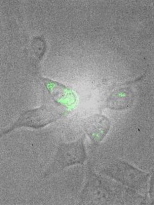Engineers from the Massachusetts Institute of Technology (MIT) have developed carbon nanotubes embedded in sensors to monitor anti-cancer drugs and other DNA-damaging substances. inside living cells

Engineers from the Massachusetts Institute of Technology (MIT) have developed carbon nanotubes embedded in sensors to monitor anti-cancer drugs and other DNA-damaging substances. inside living cells. The sensors, which consist of carbon nanotubes wrapped in DNA, are able to detect chemotherapy drugs such as cisplatin as well as environmental toxins and free radicals that damage DNA.
"We've built a sensor that can be placed in living cells, both healthy and malignant, and actually detect several different types of compounds that damage DNA," said Michael Strano, a professor of chemical engineering and one of the lead authors of a paper describing this research that appeared in the December issue of the journal The scientific Nature Nanotechnology.
Such sensors could be used to monitor chemotherapy patients to make sure the drugs are fighting tumors effectively. Many chemotherapy drugs are extremely harmful substances to DNA. and may cause severe side effects, so it is very important to make sure that the drugs actually reach the target sites for which they were intended in the first place.
"You are able to know not only the exact location of the drugs, but also whether a particular drug is active or not," said one of the researchers.
The sensor is able to detect DNA alkylating agents, a family of substances that includes the drug cisplatin and oxidizing agents such as hydrogen peroxide and hydroxyl radicals. Using the sensor, researchers or doctors are able to monitor the activity of living cells over a long period of time. The sensor is able to precisely locate the location of the compounds inside the cells, and for a certain substance - hydrogen peroxide - it is able to detect even a single compound.
The new method makes intelligent use of the fact that carbon nanotubes radiate in the near infrared light range. Human tissues do not radiate in this area, and thus it is possible to see the radiation of the nanotubes more easily.
Each nanotube is wrapped in DNA, which binds DNA-damaging substances. found in the cell. The interrelationships between d.na.a. The original and its shape associated with the materials change the intensity and/or wavelength of the light emitted from the nanotubes. The different materials produce unique emission signatures that can be identified. "We are able to differentiate between different types of compounds according to their unique type of activity," says the lead researcher.
Since they are wrapped in DNA, these nanotubes are safe to inject into living cells. Nanotubes can be produced in different lengths and wrapped in different materials - factors that affect whether they are safe or toxic to the body, says the lead researcher.
In future follow-up experiments, the researchers plan to use these sensors to test the effect of various antioxidants, such as those found in green tea, and to learn how to more effectively use chemotherapy agents that are toxic to cancer cells.
